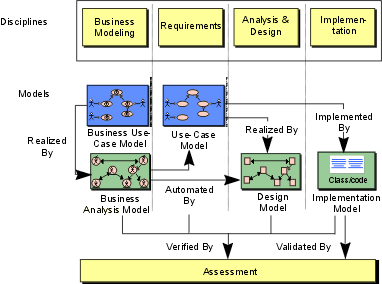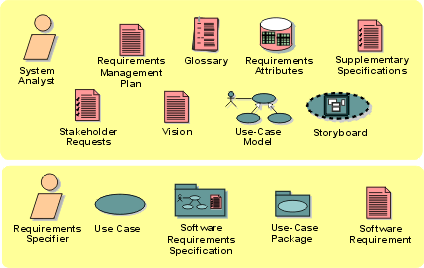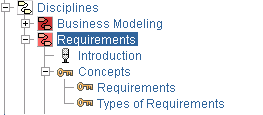Key Concept: Discipline
Topics: Discipline > Concepts
Discipline 
A discipline is a collection of related activities that are related to a major 'area of concern' within the overall project. The grouping of activities into disciplines is mainly an aid to understanding the project from a 'traditional' waterfall perspective - typically, for example, it is more common to perform certain requirements activities in close coordination with analysis and design activities. Separating these activities into separate disciplines makes the activities easier to comprehend but more difficult to schedule.

Disciplines in the treebrowser
Like other workflows, a discipline's workflow is a semi-ordered sequence of activities which are performed to achieve a particular result. The "semi-ordered" nature of discipline workflows emphasizes that the discipline workflows cannot present the real nuances of scheduling "real work", for they cannot depict the optionality of activities or iterative nature of real projects. Yet they still have value as a way for us to understand the process by breaking it into smaller 'areas of concern'.
Each 'area of concern' or discipline has associated with it one or more 'models', which are in turn composed of associated artifacts. The most important artifacts are the models that each discipline yields: use-case model, design model, implementation model and test suite.

Each discipline is associated with a particular set of models.
For each discipline, an activity overview is also presented. The activity overview shows all activities in the discipline along with the role that performs the activity. An artifact overview diagram is also presented. This diagram shows all artifacts and roles involved in the discipline.

Sample artifact overview diagram, from the requirements discipline.
It is useful to note that the 'discipline-centric' organization of artifacts is sometimes, though not always, slightly different from the artifact set organization of artifacts. The reason for this is simple: some artifacts are used across disciplines; a strict discipline-centric grouping makes it more difficult to present an integrated process. If you are using only a part of the process, however, the discipline-centric artifact overviews may prove more useful.
Concepts 
Some of the key concepts of the process, such as iteration, phase, risk, performance testing, and so on, are introduced at different levels in the process, and attached to the most appropriate process element. Some concepts are best associated to a discipline because they describe multiple artifacts and activities within this discipline.

An example of Concepts and their organization in the treebrowser
